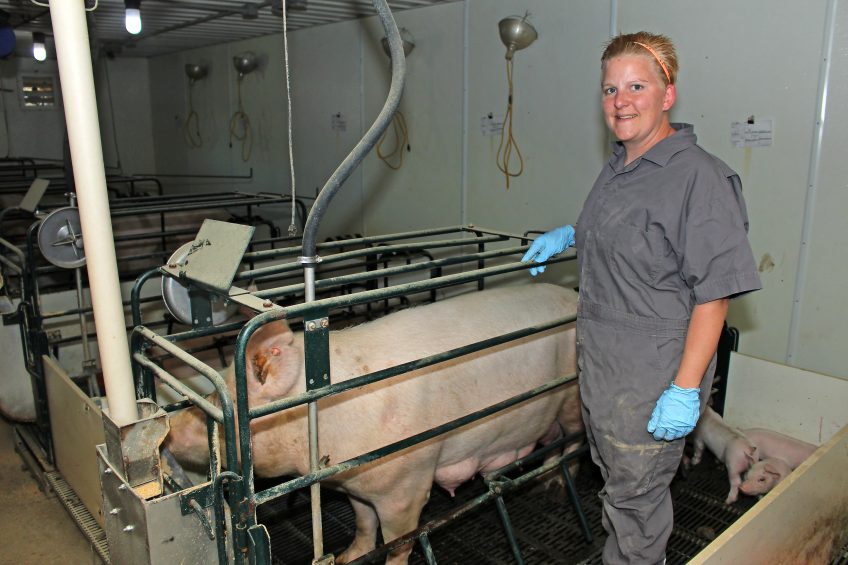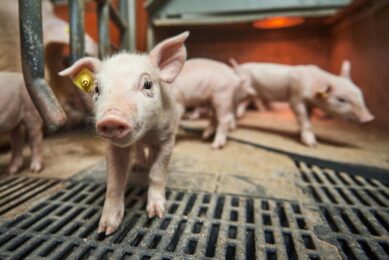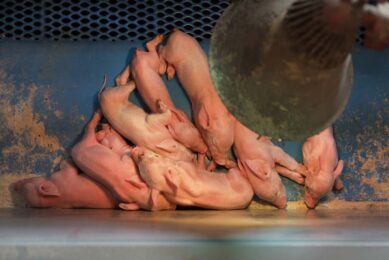Lectures and seminars in between the pigs

The sows and pigs at Iowa Lakes Community College had better not got used to seeing only one face taking care of them. Students in swine production take care of the porcine community in the college. “They are much rather inside the barns than on the school benches.”
What if you’re interested in moving into the swine business, but spending four theoretical years at university made you hesitant? Entering a community college might be an alternative. In the state of Iowa, there is exactly one place where students have the possibility to be taught in practice how to work with every aspect of the swine business – without having to leave school.
At Iowa Lakes Community College, near Emmetsburg in northern Iowa, United States, in 2013 a completely new addition was being commissioned for swine production. The college already had a small swine facility with some sows, but its aims were higher. Iowa Lakes CC wanted to cover the entire swine production chain from breeding to finishing in its own training farm. The result is something to be proud of: a 56-sow facility with 12 farrowing places, a weaner room and 360 finishing places.
Specialising into swine
Kelly Dodge has been a swine instructor at the community college farm site ever since the new facility was added. Together with 3 other colleagues she runs the site, which also houses a facility for beef cattle, with a purely educational purpose. Every year roughly 12 to 14 agricultural business students between 19 and 21 years old choose to specialise in swine in order to become a pig farm manager – they will mostly study with Ms Dodge, who takes care of the general animal science classes.
She has ample experience in the swine business, as in breeding facilities she worked before becoming an instructor. “I love the sow side, the farrowing and the breeding. I love to teach the students about everything ‘sow’,” she says. She’s relatively unique in Iowa, as in this state breeding facilities are a minority – despite being the US’ number 1 sow state. The vast majority of swine operations in Iowa are finishing-only, being close to the feed and having plenty of fields to spread out the manure.

Students come from a varied background, she thinks – some grew up in a pig farming family, but quite a few are new to the industry. The course to become a swine farm manager involves 2 years of training. Ms Dodge says, “In the second year, we encourage the students to take care of the first year students as well, so they know already how to give instructions and manage others. Data collection in e.g. the gestation room is also being done by the students. They can keep track of development of the sows and have these data digitalised using PigChamp software.”
Similarly, the students can keep an eye on technical data like feed conversion rates (FCR) or average daily gain (ADG). These data mostly are being used internally for training use only, as commercial output may be a welcome source of income, but it’s not the major goal of the facility.
Health issues
With its mission to educate, Iowa Lakes Community College farm takes a relatively open attitude to the outside world. Students come and go, and may even go home during the weekends. In addition, at certain days, members of the public are welcome to come and learn about pig production. They cannot get near the pigs, but will be allowed to enter special rooms to view the animals through special demonstration windows. Ms Dodge says, “Most people come from fairly local, but they do come from as far as Fort Dodge, IA. The kids love it, you can tell they have never been around this type of livestock.”

The college farm is aware and realistic about the biosecurity risks. To avoid as many problems as possible, the farm applies a compulsory showering-in protocol for anyone wishing to come close to the pigs. In addition, upon entrance, there is a so-called ‘Danish bench’, so shoes from outside need to be left on one side of that bench – any dirt from outside cannot be transferred into the barn. So far all these protocols have paid off. Diseases like Porcine Reproductive and Respiratory Syndrome (PRRS) or Porcine Epidemic Diarrhoea (PED) have never occurred at the farm.
Gestation barn
The gestation area and a place for 2 heat detection boars occupies the older part of the facility. The sows are kept in crates as the facility doesn’t have the space to convert to group housing and at the same time maintain the current level of production. The farm breeds its own replacement gilts as well, only semen is brought in. In order not to deviate too far from the original genetic line, a total depop-repop will be necessary in the future.

Farrowing zone
At the time of the visit, the lactation room, with 12 farrowing pens, is equipped with more than one management system. Left of the aisle, 6 lactation crates have plastic slats and water bowls – 6 on the right come with metal slats and drinking nipples. “It’s not about one being better than the other,” Ms Dodge explains, “it’s just to show students which systems exist. They can develop a preference or at least know how to deal with these systems once they start working in the business themselves.” Sows on the farm have a litter size of 13.5 piglets; the farm weans between 11 and 11.25 piglets/litter.
Profile |
Weaners
In the weaner facility, the pigs only stay 3 weeks. This is because of space restrictions. One part of the weaners has to be sold at roughly 80 lbs (36 kg). They are phase-fed; the first week of the grower phase they receive pelleted feed, the rest is mash feed. In winter, the weaners are kept on heating pads.

Finishers
The finishers stay in 3 rooms, in groups of 10-15. The barns are equipped with Osborne Industries’ wet-dry feeders, installed between each pen. The pigs stay in the farm until they weigh 280-290 lbs (127-131 kg). They go to a local slaughterhouse.

Check out – World of Pigs – on pigprogress.net for an interactive overview on swine production all around the globe and where you can find worldwide farm visits.
Feeding
Feeding for all animals mostly comes in mashed form – only the early weaning feed comes in pellets. The feed is based on a combination of corn, soy and distillers’ dried grains and solubles (DDGS) and is made by Kerber Milling, also located in Emmetsburg. Every now and then, the feed is trucked in, filling up all the feed bins.

Designed together with OsborneWhen the new pig house was decided on, Osborne Industries was the winning company in 2013 together with a range of other companies. They gave their input as to what the farm should look like. The outside structure was made by New Modern Concepts. On the inside, several approaches had to be taken into consideration. For instance type of feeding pans in the weaner and finisher houses as well as the heating pads in the farrowing rooms. |

Keeping pigs at a college site involves more labour than your average working week. After all, both the cattle as well as the pigs need taking care of during weekends and holiday months as well. Ms Dodge smiles, “Me and my colleagues do that in turns, so I have to keep an eye on them every fifth weekend on average. I just have to plan my holidays around the swine farrowing and breeding moments, because then I’d like to be there myself.”
Luckily, however, most of the time she’s far from alone with the pigs. She says, “The students love it. They would much rather be inside the barns than on the school benches.”
This farm visit was possible with the kind assistance of Osborne Industries.
Join 18,000+ subscribers
Subscribe to our newsletter to stay updated about all the need-to-know content in the pigsector, three times a week. Beheer
Beheer











 WP Admin
WP Admin  Bewerk bericht
Bewerk bericht